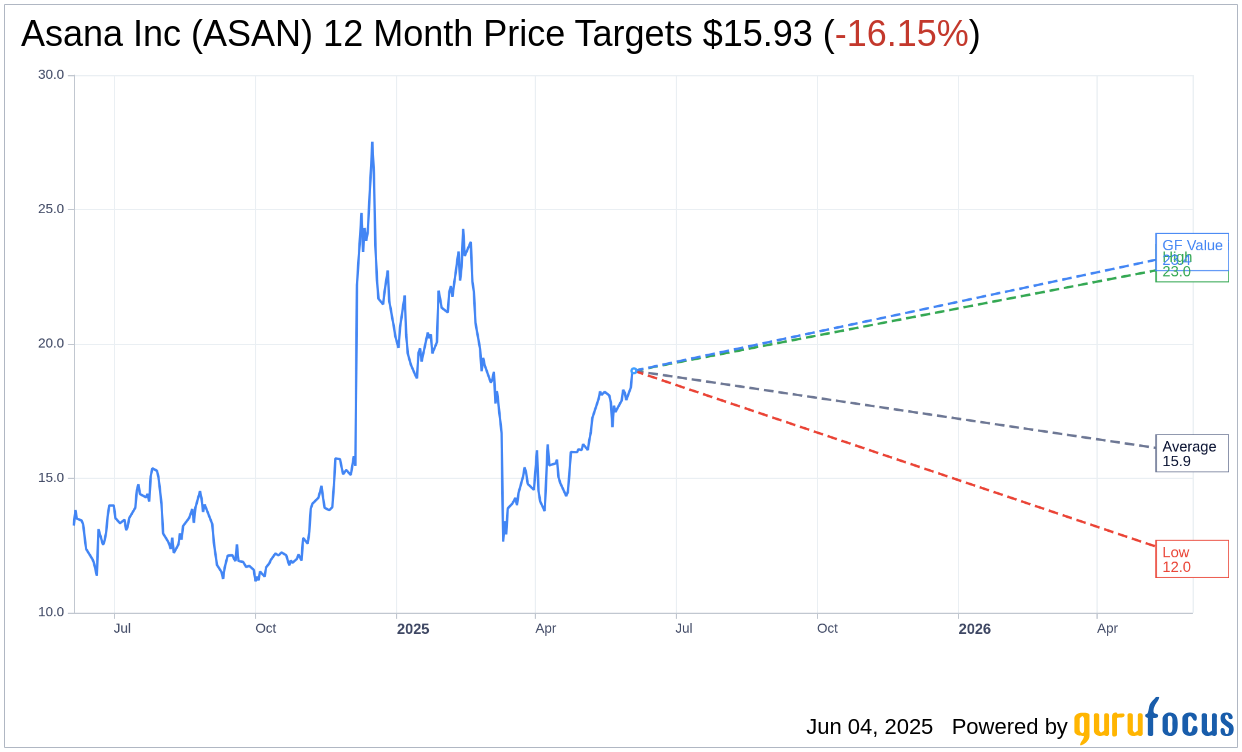Jefferies has updated its price target for Asana (ASAN, Financial), increasing it from $15 to $17 while maintaining a Hold rating on the stock. This adjustment comes despite Asana surpassing expectations in its first-quarter performance and securing a substantial $100 million deal over three years. However, this renewal saw a reduced annual contract value and was delayed beyond the first quarter, according to an analyst's insights.
Additionally, Asana is experiencing elongated sales cycles with more intense scrutiny. In light of potential macroeconomic challenges, Jefferies has revised Asana's fiscal 2026 revenue forecast, reducing the lower end by $7 million to account for possible further economic setbacks.
Wall Street Analysts Forecast

Based on the one-year price targets offered by 13 analysts, the average target price for Asana Inc (ASAN, Financial) is $15.93 with a high estimate of $23.00 and a low estimate of $12.00. The average target implies an downside of 16.15% from the current price of $19.00. More detailed estimate data can be found on the Asana Inc (ASAN) Forecast page.
Based on the consensus recommendation from 18 brokerage firms, Asana Inc's (ASAN, Financial) average brokerage recommendation is currently 2.8, indicating "Hold" status. The rating scale ranges from 1 to 5, where 1 signifies Strong Buy, and 5 denotes Sell.
Based on GuruFocus estimates, the estimated GF Value for Asana Inc (ASAN, Financial) in one year is $23.42, suggesting a upside of 23.26% from the current price of $19. GF Value is GuruFocus' estimate of the fair value that the stock should be traded at. It is calculated based on the historical multiples the stock has traded at previously, as well as past business growth and the future estimates of the business' performance. More detailed data can be found on the Asana Inc (ASAN) Summary page.
ASAN Key Business Developments
Release Date: June 03, 2025
- Total Revenue: $187.3 million, up 9% year-over-year.
- Non-GAAP Operating Margin: Improved by more than 1,300 basis points year-over-year, reaching 4%.
- Adjusted Free Cash Flow Margin: Improved by more than 700 basis points year-over-year, reaching 5%.
- Core Customers: 24,297 customers spending $5,000 or more annually, with revenue growth of 10% year-over-year.
- Customers Spending $100,000 or More: 728 customers, growing 20% year-over-year.
- Gross Margin: Approximately 90%.
- Net Income: $12 million or $0.05 per share.
- Cash and Cash Equivalents: Approximately $470.8 million.
- Share Repurchase: $15.6 million of Class A common stock repurchased.
- Q2 Revenue Guidance: $192 million to $194 million, representing 7% to 8% growth year-over-year.
- Full Year Revenue Guidance: $775 million to $790 million, representing 7% to 9% growth year-over-year.
For the complete transcript of the earnings call, please refer to the full earnings call transcript.
Positive Points
- Asana Inc (ASAN, Financial) achieved non-GAAP profitability for the first time in Q1 fiscal year 2026, marking a significant milestone.
- AI Studio reached general availability and surpassed $1 million in ARR, demonstrating strong early momentum.
- Total revenues increased by 9% year-over-year, exceeding the top end of guidance.
- Non-tech verticals grew faster than overall growth, with manufacturing, energy, media, entertainment, and financial services showing strong performance.
- A landmark $100 million-plus contract renewal with one of the largest employers in the world highlights Asana's enterprise capabilities.
Negative Points
- The $100 million-plus renewal, while significant, resulted in a modest ACV downgrade, impacting net retention rates.
- There is increased buyer scrutiny and elongation in decision-making processes, particularly in enterprise and tech verticals.
- Net retention rate (NRR) is expected to be pressured in Q2 due to downgrade pressures in enterprise and middle market segments.
- The macroeconomic environment presents risks, with potential for elongated sales cycles and increased budget scrutiny.
- Despite strong new business momentum, downgrade pressures and macroeconomic risks may limit the reflection of growth in overall revenue.
